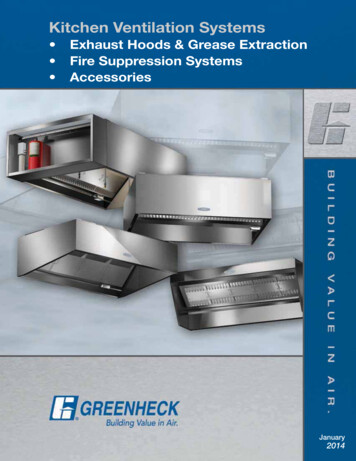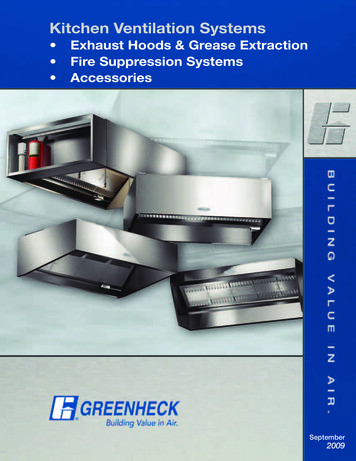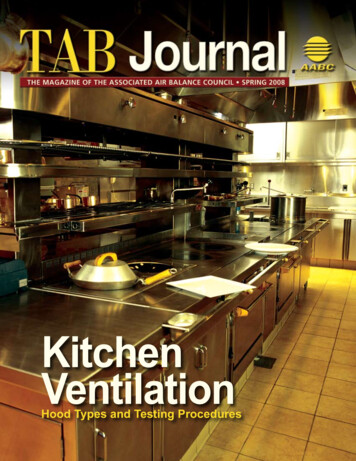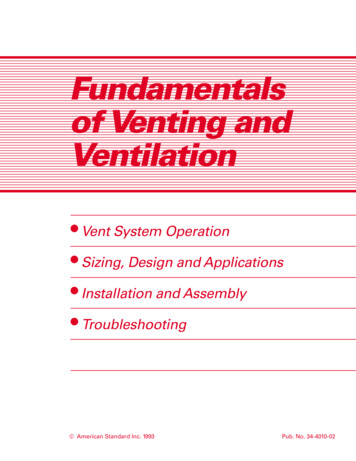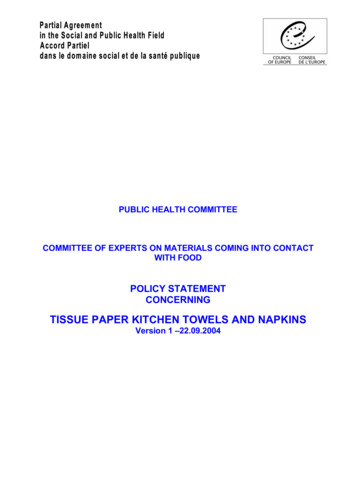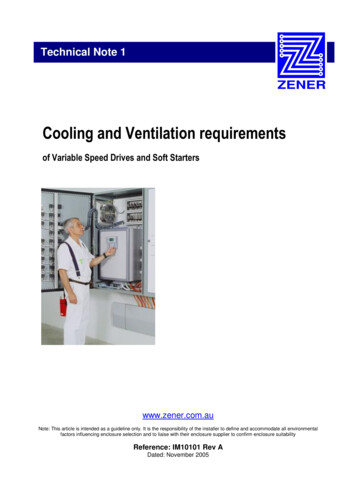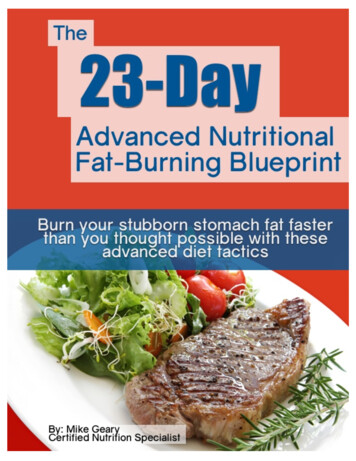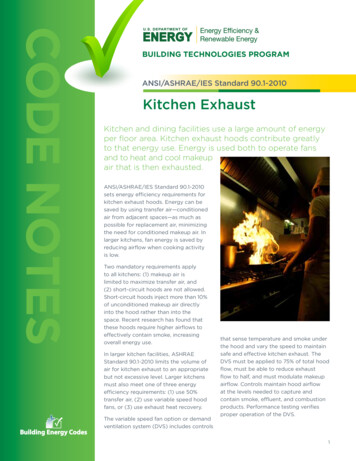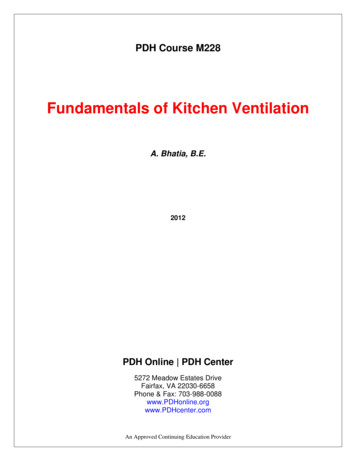
Transcription
PDH Course M228Fundamentals of Kitchen VentilationA. Bhatia, B.E.2012PDH Online PDH Center5272 Meadow Estates DriveFairfax, VA 22030-6658Phone & Fax: 703-988-0088www.PDHonline.orgwww.PDHcenter.comAn Approved Continuing Education Provider
www.PDHcenter.comPDH Course M228www.PDHonline.orgFundamentals of Kitchen VentilationA. Bhatia, B.E.Course ContentIntroductionVentilation is the single most important factor in the design, construction and operation of commercialkitchens. Without adequate ventilation and an ample supply of clean makeup air, no kitchen will operateefficiently. There are particular objectives which the ventilation has to achieve. The objectives include thefollowing:1) The general ventilation through the kitchen has to introduce sufficient clean, cool air and remove excess hot airfor the occupants to breathe adequately and remain comfortable.2) The general ventilation has to provide sufficient air for complete combustion at burning appliances, otherwisechronic debilitating carbon monoxide poisoning could occur.3) The general and local ventilation has to dilute and remove products of combustion from gas and oil firedappliances.4) The general and local ventilation has to dilute and remove odors, vapors and steam from the cooking processes.5) Local ventilation has to protect against particular hazards to health arising from some cooking fumes, such asthose involving direct application of heat to the food.6) The local ventilation has to be capable of being kept clean from fat residues to avoid loss of efficiency and firerisks.7) The system has to be quiet and vibration free.The amount of ventilation required in a particular cooking area depends on various factors: the type ofproduct(s) being cooked, the structure which houses the cooking area, the type of equipment used andlocal code regulations. And, depending on your location, the building heat source may also play a factor.This course will provide basic guidelines to achieve these objectives and facilitate ventilation design. Let’sfirst understand key terminology and definitions related to kitchen ventilation systems.Definitions1) Anemometer -A device used to measure air velocity.2) Approved - Acceptable to the regulatory authority based on a determination of conformity withprinciples, practices, codes, and generally recognized standards.3) Balance Report - A report completed by a qualified person, who after on-site testing of a ventilationsystem, specifies in a report certain air volumes and the building’s overall static pressure.4) Compensating Supply Air - Air supplied through a plenum in the hood which is directed into the hoodscapture area or down along the hood’s perimeter.5) Convection Oven – A gas or electric heated oven that uses a fan or blower to recirculate the heatthroughout the interior of the oven6) Damper - A plate or other device within a duct for controlling the flow of gases.7) Duct - means an enclosure for the transmission of air and vapors.8) Grease - means rendered animal fat or vegetable shortening in any form, associated with cookingand other food preparation. 2012 A. BhatiaPage 2 of 30
www.PDHcenter.comPDH Course M228www.PDHonline.org9) Grease Extractor - A device or a system of components (usually series of baffles installed in a hood)for reducing the grease concentration from the air stream entering the system and concentrating thegrease for further action.10) Grease Filter - A device that is installed in the exhaust hood in such a way as to remove grease fromthe exhausted air by entrapment, impingement, adhesion, or other similar means and allow it to drainto a grease trough.11) Grease Laden Vapors/Air - Vapors in concentrated level of above 5 mg. per cubic meter released intothe air due to grease being heated to its vaporization point.12) Grease Removal Devices - Any device for removing vapor suspended grease particles from an airstream.13) Hood – An air-intake device connected to a mechanical exhaust ventilation system for collecting andremoving cooking effluent which contains grease, vapors, fumes, smoke, steam, heat, or odors whichare generated by cooking equipment and ware-washing machines. Canopy Hood – A hood designed in a way that it’s inside edge overhangs or extends theequipment on all exposed sides (usually not less than six inches beyond the outer edges of thecooking surface) and capture large surges of contaminated air. Compensating Hood – A hood that is designed to introduce supply air through an integral plenumeither directly into the hood capture area or by directing air down along the hood perimeter. Thisdesign will typically provide 60-80% of the required makeup air through four basic dischargemethods: short-circuit, face-discharge, back-discharge, and down discharge. These methods mayalso be combined, such as a face and down discharge arrangement. Island Hood - A canopy hood that is mounted from the ceiling with all four sides or the longitudinalsides exposed. Back-Shelf Hood - A hood designed to be mounted behind the equipment and which does notoverhang the front of the equipment. Eye-Brow Hood - A hood designed to capture the vapors and heat escaping the open doors ofequipment and which is located above and overhangs the door openings. Vent Hood - A hood designed to capture and remove steam, fumes, and heat but not grease. Short-Circuit Hood - A compensating hood with an integral plenum which discharges supply airdirectly into the hood’s capture area.14) Listed Equipment – Equipment and materials which, following evaluation and acceptance by aqualified testing agency, are placed on a list of certification. The listing shows that the equipment andmaterials comply with accepted national standards, which have been approved or evaluated forconformity with approved or national standards.15) Makeup Air - Means forced and/or passive air entering a space that replaces air exhausted from thespace. Makeup air consists of compensating supply air, other supply air delivered through the hoodsuch as front face discharge and supply air delivered through ceiling and wall diffusers.16) Non-canopy Hood – A hood that does not extend completely over the cooking equipment. A noncanopy hood is designed to be as close as possible to the cooking surface, usually 18 to 24 inchesabove it.17) Overshelf - Any equipment such as a shelf, cheese-melter, bun warmer, or salamander which islocated over cooking equipment and below a hood exhaust plenum.18) Plenum – An air compartment or chamber to which one or more ducts are connected and whichforms part of the supply-air, return-air, or exhaust air system.19) Portable – Equipment having the properties of being portable, weighing less than 80 pounds, notexceeding three feet in any plane, and having utility connections designed to be disconnected or ofsufficient length to permit equipment movement for cleaning. 2012 A. BhatiaPage 3 of 30
www.PDHcenter.comPDH Course M228www.PDHonline.org20) Recirculating System - A system for controlling the smoke or grease-laden vapors from commercialcooking equipment that does not exhaust to the outside.21) Smoke Bomb - A device which releases smoke in order to simulate the operation of smoke and vaporproducing equipment for test purposes.22) Type I Exhaust Hood – A hood that is designed to collect and remove all types of cooking effluentfrom the exhausted air.23) Type II Exhaust Hood – A hood that is designed to collect and remove only steam, vapors, heat, orodors.24) Thermal Imaging – A technique used in understanding the behavior of thermal plumes and foridentifying visually all the convective heat coming off the appliances. A Schlieren system and CFD(Computational Fluid Dynamics) is a thermal imaging technique widely used by kitchen appliancemanufacturers in developing energy efficient and comfortable ventilation systems and products.25) Water-Wash-Type Exhaust Hood – a Type I hood which uses water to remove accumulated greasefrom the grease extractors.KITCHEN EXHAUST SYSTEMSKitchen exhaust systems are made of a number of interdependent units. Exhaust hoods, exhaust fans,makeup air units, and packaged rooftop HVAC (Heating Ventilation Air Conditioning) units all need tooperate within defined parameters to complement one another and to maintain peak performance. Aneffective exhaust system should get rid of: Heat particulate matter grease laden steam cooking vaporsWhile an exhaust hood serves that purpose, the key question is always: what is the appropriate exhaustrate? The answer always depends on the type (and use) of the cooking equipment under the hood, thestyle and geometry of the hood itself, and how the makeup air (conditioned or otherwise) is introducedinto the kitchen.KITCHEN HOOD TYPESKitchen hoods can be categorized into two basic types: backshelf or proximity hoods and canopy hoods:BACKSHELF HOODSBackshelf or proximity hoods do not overhang the front of the equipment and are designed to be mountedbehind the equipment. These hoods may be selected for use in applications where overhead canopiesare impractical (such as a low ceiling height), or in other situations where an overhead canopy is notdesirable. These are best suited for low cooking surface appliances such as griddles, grills, fryers, etc.Key Facts1) The backshelf hood is placed in close proximity to the cooking surface thus requires less exhaustthan a canopy hood used in the same application. This makes the backshelf hood to be widely usedin quick-service and short-order foodservice establishments that typically use fryers and griddles astheir primary cooking equipment.2) The backshelf hood is not suitable for tall appliances or facilities that produce large volumes ofeffluent or steam. These are not recommended for open flame equipment such as char-broilers.3) Backshelf hoods are available as exhaust only hoods i.e. these have no provision for introducingtempered or un-tempered air integral to the hood. Makeup air is provided independent from thekitchen hood system.4) The length of a backshelf should be a minimum of the length of the cooking equipment. Backshelfhoods should be located to provide a minimum of 18” and a maximum of 24” from the cooking surface 2012 A. BhatiaPage 4 of 30
www.PDHcenter.comPDH Course M228www.PDHonline.orgto the filters, and the distance from the front of the hood to the front of the cooking surface should notexceed 12”.CANOPY HOODSA Hood designed in a way that it’s inside edge overhangs or extends the equipment on all exposed sides.Key Facts1) Canopy hoods have a large overhang usually not less than six inches beyond the outer edges of thecooking surface, which improves the capture effect and restricts the outward expansion of the gases.(Overhang is the space between the edge of the cooking equipment and the edge of the hood in avertical plane).2) Canopy hoods with large overhang are recommended for appliances that create plume surges, suchas convection and combination ovens, steamers, char-broilers and pressure fryers.3) Canopy hoods require larger volumes of exhaust air than the backshelf design. As a result, they aresuitable for ventilating any type of cooking operation and are flexible as to where they can be placed;i.e. next to a wall or in the center of a kitchen with a 360º cooking radius.Canopy hoods are classified by installation characteristics i.e. installation against a wall (wall hood)installation as an island over a single line of cooking equipment (single island hood), or installation as anisland over a double line of equipment placed back to back (double island hood).Within each classification canopy hoods are further subdivided as canopy hoods, grease extractors andhigh velocity hoods.1) Grease Filter Hoods - Those which use removable filters and must be removed and manuallywashed.2) Grease Extractor Hoods - Those with internal baffles and may include an internal wash system ormay be manufactured as cartridges for manual washing.Both are subject to the same standards when evaluated by an independent testing agency.FILTER HOODSThe most frequently used hood arrangement contains metal filters, where the exhaust fan draws kitchenair into the canopy through a filter. The primary purpose of these filters is to ensure that the effluents aredrawn straight into the canopy and liquid grease droplets are removed efficiently entrapment,impingement, adhesion, or other similar means from the air stream. Pre-code filters were typically wiremesh that removed grease by impingement. Such filters are no longer permitted due to their flammabilityand the rapid increase in pressure drop associated with grease collecting and congealing in the filters. 2012 A. BhatiaPage 5 of 30
www.PDHcenter.comPDH Course M228www.PDHonline.orgKey Facts1) Maintain a 20 to 60 feet per minute velocity at the front edge. The edge velocity is in part related tothe speed of exhaust gases entering the filters but diminished by the distance away from the samefilter. Large filters will cause low air pressure drop and very low edge velocity.2) The filters are installed in a vertical position to no less than 45 degrees off horizontal plane. Theefficiency of these filters is approximately 50 to 60%, by weight.3) Filter hoods are referred to as Bulletin 96 canopies, a reference to NFPA Bulletin 96 which governsconstruction requirements for commercial kitchen applications. Underwriters Laboratories establishesthe standards for the filters, which are known as UL Classified Filters.GREASE EXTRACTORGrease Extractor Hoods use internal baffles to remove grease and may include an internal wash systemor may be manufactured as cartridges for manual washing. The Grease Extractor draws exhaust airthrough a linear slot and creates velocities at the front edge of the cooking equipment of 20 to 60 feet perminute. The face area of linear slot is much lower than the face area of the filter hood, which results inhigher capture velocity at the front edge of the cooling equipment (or lower CFM/linea
www.PDHonline.org www.PDHcenter.com . www.PDHcenter.com PDH Course M228 www.PDHonline.org 2012 A. Bhatia Page 2 of 30 Fundamentals of Kitchen Ventilation A. Bhatia, B.E. Course Content Introduction Ventilation is the single most important factor in the design, construction and operation of commercial .
